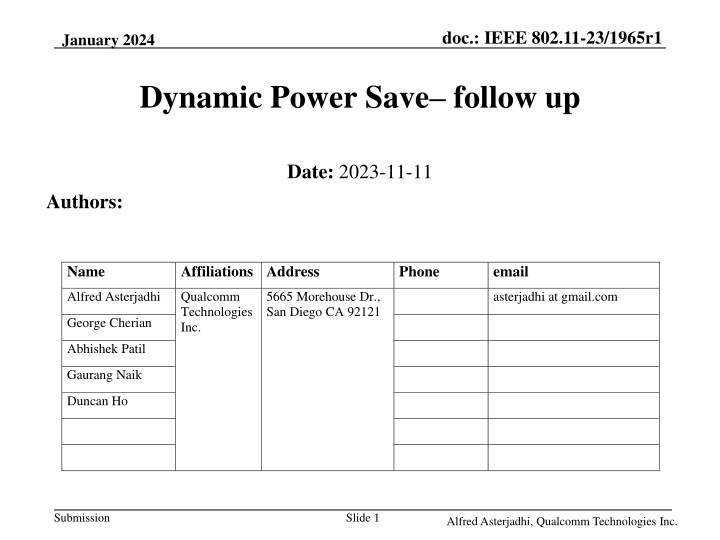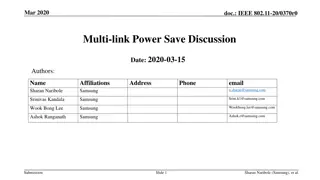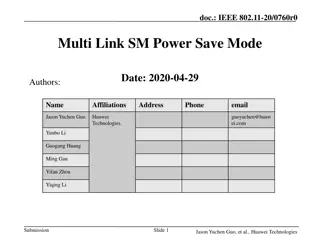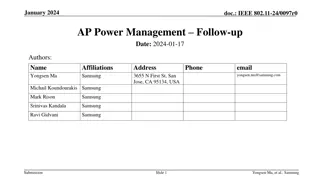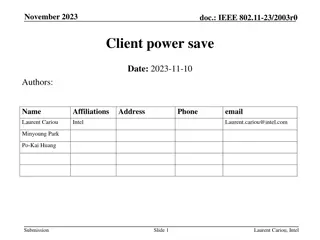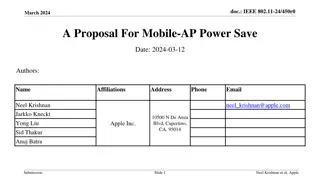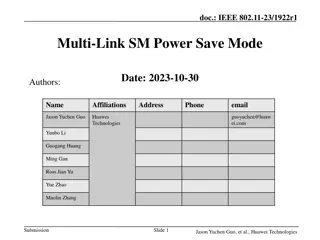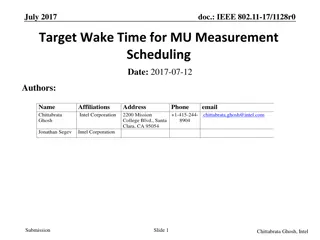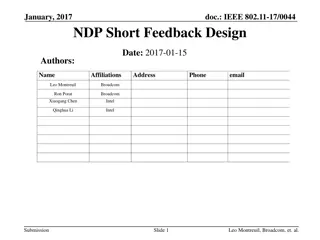IEEE 802.11-23/1965r1 Dynamic Power Save Mechanism Overview
The IEEE 802.11-23/1965r1 document from January 2024 discusses the implementation of a dynamic power save mechanism for WLAN devices, focusing on reducing power consumption for Access Points (APs) and non-AP stations (STAs). The proposal aims to improve power consumption efficiency for both devices by introducing mechanisms for reducing AP power consumption and enhancing Peer-to-Peer (P2P) operation. The document also emphasizes the importance of prolonging battery life, reducing device costs, and lowering energy bills for various scenarios. Various frame exchange strategies and candidate features are explored to achieve these objectives.
Download Presentation

Please find below an Image/Link to download the presentation.
The content on the website is provided AS IS for your information and personal use only. It may not be sold, licensed, or shared on other websites without obtaining consent from the author.If you encounter any issues during the download, it is possible that the publisher has removed the file from their server.
You are allowed to download the files provided on this website for personal or commercial use, subject to the condition that they are used lawfully. All files are the property of their respective owners.
The content on the website is provided AS IS for your information and personal use only. It may not be sold, licensed, or shared on other websites without obtaining consent from the author.
E N D
Presentation Transcript
doc.: IEEE 802.11-23/1965r1 January 2024 Dynamic Power Save follow up Date: 2023-11-11 Authors: Name Affiliations Address Phone email Alfred Asterjadhi Qualcomm Technologies Inc. 5665 Morehouse Dr., San Diego CA 92121 asterjadhi at gmail.com George Cherian Abhishek Patil Gaurang Naik Duncan Ho Submission Slide 1 Alfred Asterjadhi, Qualcomm Technologies Inc.
doc.: IEEE 802.11-23/1965r1 January 2024 Introduction UHR SG discussed AP power save (PS) in several contributions [1, 2, 3, 4] Which focus on the need for mechanisms to reduce AP power consumption and Discussed viable candidate features that can achieve this goal Consequently, the UHR SG agreed [5] to defining a mechanism to reduce power consumption for Access Points (APs) (including mobile APs) and improved Peer-to-Peer (P2P) operation compared to the Extremely High Throughput MAC/PHY operation. In addition, the UHR SG also acknowledged that Reducing power consumption of WLAN devices is required to prolong the battery life of untethered devices (e.g., non-AP STA, Mobile APs), reduce device cost, and lower energy bills of customers deploying non-AP and AP STAs in most scenarios (e.g., residential, enterprise, industrial, venues). Submission Slide 2 Alfred Asterjadhi, Qualcomm Technologies Inc.
doc.: IEEE 802.11-23/1965r1 January 2024 Overview We propose to generalize the dynamic PS concept [1, 2] So that it is applicable at both AP and STA side Improving power consumption for both devices And continue with some design details related to Choice of initial control frame Specific details that depend on the type of device Submission Slide 3 Alfred Asterjadhi, Qualcomm Technologies Inc.
doc.: IEEE 802.11-23/1965r1 January 2024 Dynamic Power Save Frame Exchange/TXOP Frame Exchange/TXOP <160MHz, 2SS> <80MHz,1SS> <20MHz,1SS> Non-HT (dup) PPDU Beacon Beacon Data Data ICF ICR ICF ICR BA BA STA is in Listen State unless solicited to transition to Awake state Listen State: STA is only capable of RX PPDUs of certain configuration E.g., non-HT (dup) PPDUs, and mandatory data rates Awake State: STA is capable of RX PPDUs with highest BW/NSS E.g., as advertised in most recent Caps/OMN/OM Control (for both AM and PS modes) Initial control frame (ICF) causes transition from listen to awake state 1. RTS frame is one candidate since its generation is supported by both APs and STA Cons: PIFS-based CCA requires STA in full BW; No padding available for extra processing time And modifying the frame format can lead to legacy/interoperability issues 2. MU RTS Trigger frame is another candidate since it does not have the above cons But needs to be enabled in transmission at the STA side to enable dynamic PS 3. BAR frame is another candidate since its generation is supported by both APs and STA But padding needs to be added for extra processing time In the following we focus on the last two candidates Submission Slide 4 Alfred Asterjadhi, Qualcomm Technologies Inc.
doc.: IEEE 802.11-23/1965r1 January 2024 ICF: MU RTS Trigger vs BAR frame Frame Exchange/TXOP Frame Exchange/TXOP <160MHz, 2SS> <80MHz,1SS> <20MHz,1SS> Non-HT (dup) PPDU M-RTS Beacon Beacon BAR Data Data CTS BA BA BA MU RTS Trigger frames: AP: TX of MU RTS Trigger frame is already supported Currently only allowed to be broadcast; should enable unicast as well STA determines from RA whether it needs to prepare response Has padding properties; could inherit rules from eMLSR Non-AP STA: Needs enablement in TX of MU RTS Trigger frame Enable unicast MU RTS Trigger frame; RA set to MAC address of the AP Required if AP advertises that is operating in dynamic PS mode AP advertises the amount of padding required when the AP is in dynamic PS mode BAR frames: Already supported by both AP and STA Mandatory support for C-BAR and optional support for Multi-TID BAR Does not have padding; although can be added (see next slides) Slide 5 Submission Alfred Asterjadhi, Qualcomm Technologies Inc.
doc.: IEEE 802.11-23/1965r1 January 2024 ICF: MU RTS Trigger/BAR frame Octets: 2 2 6 6 2 0 or 2 variable 4 Frame Control BAR Control BAR Duration RA TA Padding FCS Information BAR frame Frame Control Common Info MU RTS Trigger frame Duration RA TA User Info List Padding FCS Octets: 2 2 6 6 8 Nx5 variable 4 Padding: Inherited from eMLSR & design from Trigger frame Inclusion of intra-MPDU FCS/MIC [6, 7] FCS/MIC field prior to padding helps verify contents well in advance MIC present when frame is protected [6] & FCS present when frame is not [7] Inclusion of additional feedback Enables flexible delivery of control information Information beneficial from a dynamic PS perspective in next slides Submission Slide 6 Alfred Asterjadhi, Qualcomm Technologies Inc.
doc.: IEEE 802.11-23/1965r1 January 2024 MU RTS vs BAR frame: Comparison Overhead Comparison (focusing on single user): MU RTS: Common Info + User Info + Special User Info (320 MHz) Most subfields of these fields are reserved/unnecessary (except BW, AID, At least for the purpose of dyn. PS (good to have BW, NSS though, see next slide) Airtime for transmitting these 2 (or 3) fields is 20 us (or 24 us) at 6 Mbps BAR: BAR Control + BAR Information (2 octets + NT*2) BAR Control needed to distinguish variants; 8 reserved bits available to use BAR Information needed when soliciting BlockAck Bitmaps (for set of TIDs) For DPS no need to solicit BlockAck bitmaps; one bit in the BAR Control can say so Airtime for transmitting these 2 octets (BAR Control) is 4 us at 6 Mbps; Comparison of other functionalities: MU RTS Trigger solicits CTS frame, which is 14 octets long and not flexible; has CTS timeout reset property BAR frame solicits a C/M-BA (used to also Ack), which is at least 24 octets, and is flexible; ignores CS to ack Submission Slide 7 Alfred Asterjadhi, Qualcomm Technologies Inc.
doc.: IEEE 802.11-23/1965r1 January 2024 Dyn. Power Save Optimizations Feedback Control in ICF/ICR allows for additional optimizations 1. Advertises the BW planned to be used for that TXOP/exchange BW must be same or narrower to what was advertised in the ICF Pros: STA needs not open full BW but simply as much as advertised by ICF 2. Enable advertisement of RX NSS in ICF RX NSS must be same or narrower to what was advertised in ICF Pros: STA needs not use full RX NSS but simply as much as advertised by ICF Remaining SSs may be turned off or used for other purposes (links, techs, etc.) 3. Enable dynamic BW negotiation with ICF/ICR exchange (unicast only) Pros: Inherit the benefits of legacy dynamic BW negotiation of RTS/CTS 4. Etc. Note: These are beneficial from coexistence perspective as well [ref.] Submission Slide 8 Alfred Asterjadhi, Qualcomm Technologies Inc.
doc.: IEEE 802.11-23/1965r1 January 2024 Conclusions We continued discussions on PS protocols aiming at Minimizing power consumption while ensuring that STAs continue to be serviced without disruptions Accounting for the necessary trade-offs/constraints Which arise due to use cases/scenarios and/or device configurations We generalized dynamic AP PS concept to also cover the STA side Giving some more details on the expected behaviors, Pointing out certain limitations to the use of RTS/CTS, and Proposed using MU RTS/BAR frame to overcome these limitations Submission Slide 9 Alfred Asterjadhi, Qualcomm Technologies Inc.
doc.: IEEE 802.11-23/1965r1 January 2024 Straw Poll 1 Do you support to define a power save mode for an UHR STA wherein the STA may transition from a lower operation mode to a higher operation mode, for a duration of time (e.g., TXOP or Service Period), upon reception of a specific initial Control frame from a peer UHR STA? Lower operation mode (e.g., 20 MHz BW, one SS, limited data rates, etc.) Higher operation mode (e.g., parameters advertised in Capability/Operation elements, OM Control, etc.) Which is the specific Control frame is TBD Whether the mode can be used by a non-mobile AP is TBD Submission Slide 10 Alfred Asterjadhi, Qualcomm Technologies Inc.
doc.: IEEE 802.11-23/1965r1 January 2024 Straw Poll 2 Do you support that an UHR STA may request a peer UHR STA to initiate frame exchanges, which require the UHR STA to be in higher operation mode, with an initial control frame? Submission Slide 11 Alfred Asterjadhi, Qualcomm Technologies Inc.
doc.: IEEE 802.11-23/1965r1 January 2024 References [1] 11-23/10r0 Considerations for enabling AP power save , Alfred Asterjadhi et. al. [2] 11-23/15r0 AP MLD power management , Liwen Chu, et. al. [3] 11-23/225r0 Considering unscheduled AP power save , Guogang Huang et. al. [4] 11-23/244r1 AP Power Save PAR addition proposal , Amelia Andersdotter, et. al. [5] 11-23/480r3 UHR Proposed PAR , Laurent Cariou, et. al. [6] 11-23/312r0 Thoughts on Secure Control frames , Alfred Asterjadhi, et. al. [7] 11-23/1873r0 Post-FCS MAC Padding , Sindhu Verma, et. al. Submission Slide 12 Alfred Asterjadhi, Qualcomm Technologies Inc.
